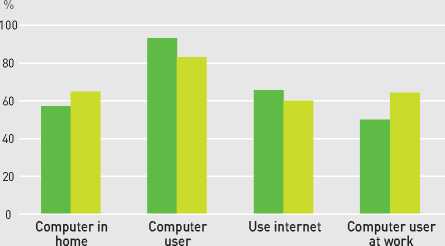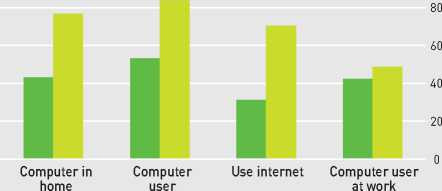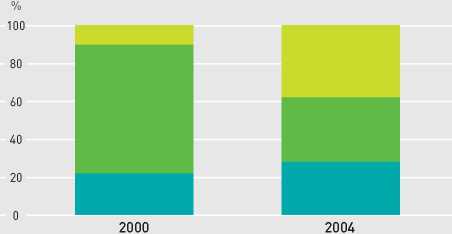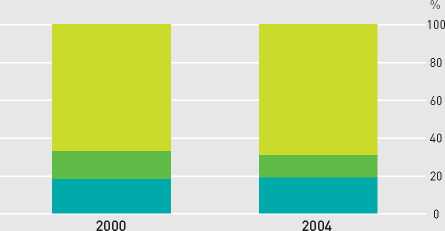4 RESEARCH SUMMARY
DESCRIPTIVE TRENDS
The first stage of analysis was to compare changes
in literacy proficiency and take-up of computer use
and time spent in employment in the two countries
over the four years between 2000 and 2004.
Literacy
In Portland there was little evidence of change
between literacy test scores either for the overall
sample or for men and women separately.
In the London sample a literacy test score was only
available at age 34 so change could not be
assessed. However, respondents were asked at
both time points if they had basic skills difficulties.
In 2000 12% reported having difficulties with
reading, writing or number work; this reduced to
8% in 2004. Men were more likely than women to
report difficulties in both 2000 (20% to 6%) and 2004
(13% to 3%).
Computer use
Figures 1a and 1b below show that while computer
use at work rose steadily in Portland, computer
ownership and use at home jumped dramatically in
London from 43% in 2000 to 76% in 2004. Growth in
computer use at home or at work levelled off and
declined slightly in Portland. A little over 80% of
both populations were using computers by 2004.
Employment
In conformity with labour-market trends, there was
clear evidence of fuller and more sustained
employment in the London sample between 2000
and 2004 compared to Portland (see Figure 2).
Although about 20% of the workforce was out of the
labour market in both locations at both times, a
much higher proportion of workers in the London
sample worked consistently every week at both
time points - nearly 70% compared with just 10% in
Portland in 2000. However, in 2004 38% of Portland
area workers had been in consistent full-time
employment.
The increase in full-time employment in Portland
was coupled with a 90% increase in the proportion
of jobs using computers by 2004. In 2000 64% of
those with a job in Portland were using computers
at work in 2004, compared with 48% in London.
Figure 1 Comparative BCS70 & LSAL digital divide indicators
• 2000 2004
Figure 1b: BCS70 Computer use 2000 & 2004
Figure 1a: LSAL Computer use 2000 & 2004

%
100

Figure 2 Comparative BCS70 & LSAL employment trends
• no weeks • some weeks • all weeks
Figure 2b: BCS70 weeks worked in previous 104
Figure 2a: LSAL weeks worked in previous 104


More intriguing information
1. Behaviour-based Knowledge Systems: An Epigenetic Path from Behaviour to Knowledge2. The name is absent
3. Lending to Agribusinesses in Zambia
4. Detecting Multiple Breaks in Financial Market Volatility Dynamics
5. MULTIPLE COMPARISONS WITH THE BEST: BAYESIAN PRECISION MEASURES OF EFFICIENCY RANKINGS
6. The name is absent
7. Mergers under endogenous minimum quality standard: a note
8. The name is absent
9. The name is absent
10. The name is absent